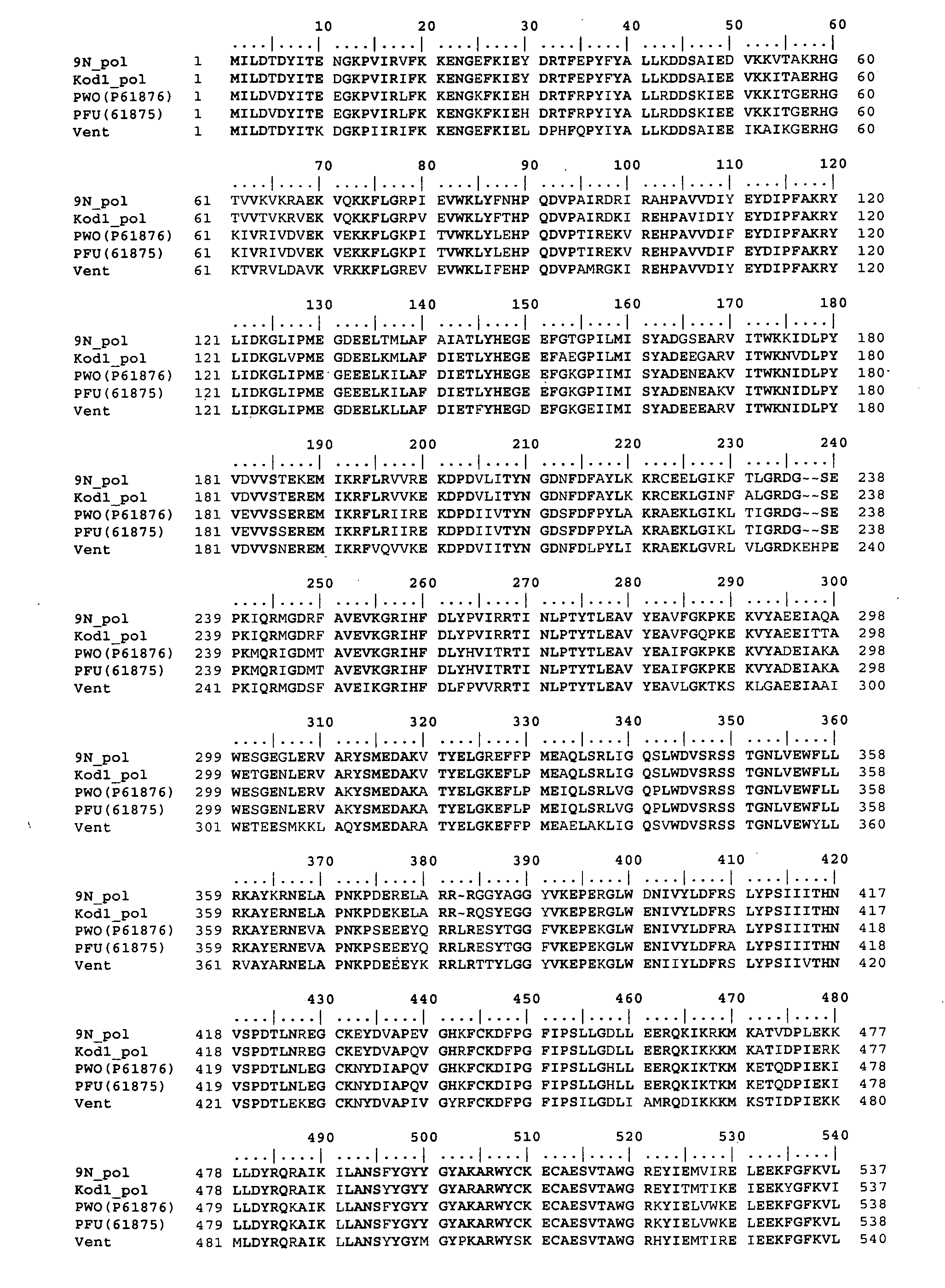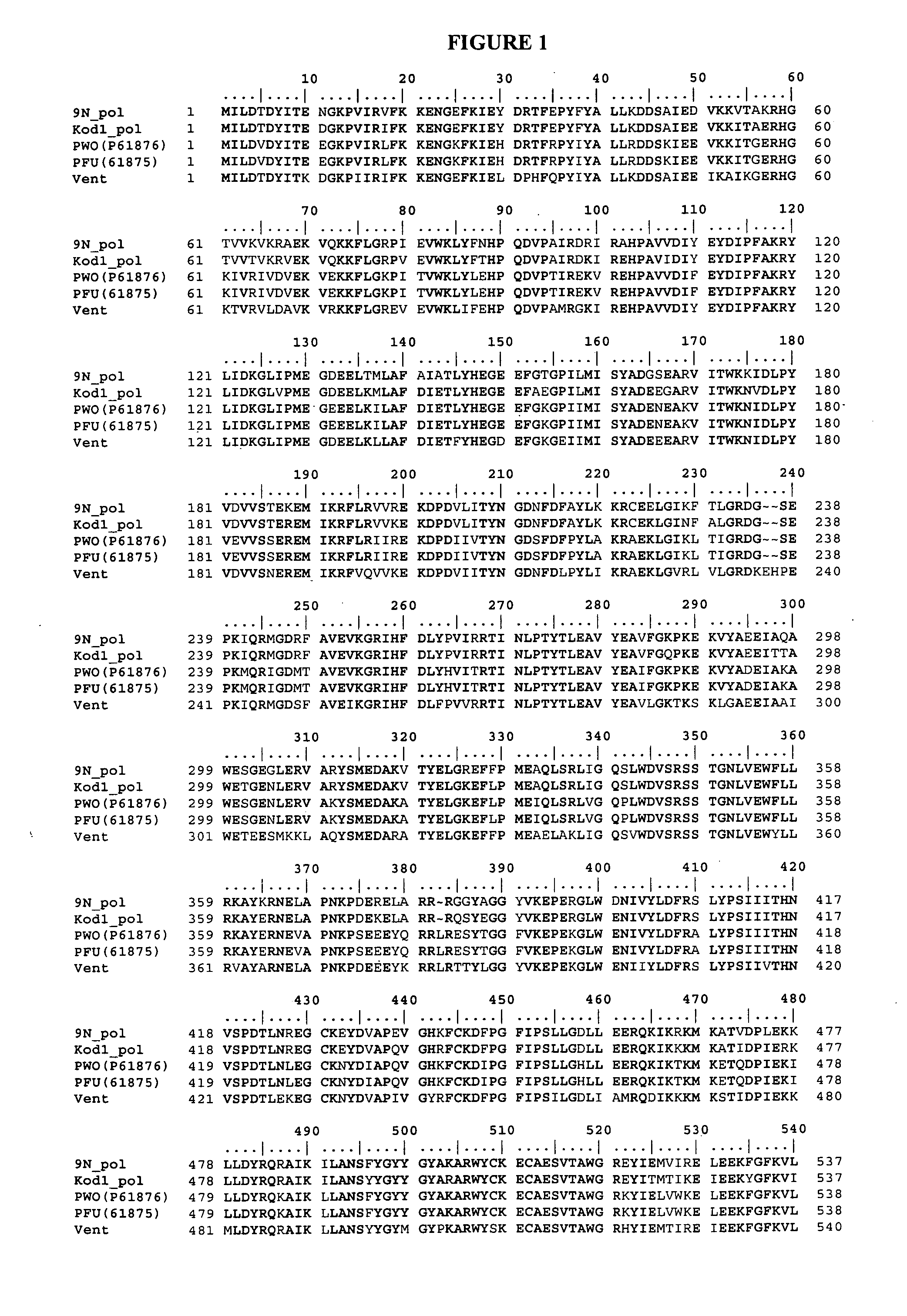[0012] The present invention provides novel mutant DNA polymerases that possess altered
kinetics for incorporating
phosphate-labeled nucleotides during
polymerization. One major
advantage of the mutant polymerases of the present invention is their faster incorporation kinetics for phosphate-labeled deoxynucleotide-triphosphates (dNTPs) during polymerization of DNA strands in comparison to native DNA polymerases. Another
advantage of the present invention is that the mutant DNA polymerases reduce the cost of sequencing and
genotyping due to their altered kinetics (e.g., faster kinetics). As such, the mutant DNA polymerases can be employed in various methods, including single-molecule
DNA sequencing and genotyping methods.
[0013] In one embodiment, the present invention provides a mutant
DNA polymerase, wherein the
amino acid sequence of the phosphate region of said mutant
DNA polymerase comprises two or more mutations not present in the phosphate region of the most closely related native
DNA polymerase, and wherein said two or more phosphate region mutations increase the rate at which said mutant DNA
polymerase incorporates phosphate-labeled nucleotides. In a related embodiment, the mutant DNA
polymerase, or at least the phosphate region of said mutant polymerase, is derived from a Family A or Family B polymerase. In yet another related embodiment, the mutant DNA polymerase is a chimera combining homologous regions from distinct polymerases (as described, e.g., by Wang et al., J. Biological
Chemistry, 270:26558-26564 (1995); Villbrandt et al.,
Protein Engineering, 13:645-654 (2000); Boudsocq et al., J. Biological
Chemistry, 279:32932-32940 (2004)). For example, the phosphate region of one polymerase could be swapped for the phosphate region of another polymerase to create a new chimera.
[0014] In another embodiment, the invention provides a mutant 9°N DNA polymerase, wherein the
amino acid sequence of the phosphate region of the 9°N DNA polymerase comprises two or more mutations not present in the phosphate region of native 9°N DNA polymerase, and wherein the two or more phosphate region mutations increase the rate at which said mutant DNA polymerase incorporates phosphate-labeled nucleotides. In a related embodiment, the mutant 9°N DNA polymerase incorporates phosphate-labeled nucleotides at an increased rate relative to 9°N-A485L DNA polymerase (SEQ ID NO: 2), comprises an
alanine to
leucine mutation at
amino acid position 485, and further comprises one or more additional mutations in its phosphate region. In yet another related embodiment, the one or more additional mutations are selected from the group consisting of a
mutation at amino acid position 352, 355, 408, 460, 461, 464, 480, 483, 484, and 497, and combinations thereof. In another related embodiment, the mutant 9°N DNA polymerase comprises a
mutation at amino acid position 484 as one of the additional mutations. In yet another related embodiment, the additional mutations include mutations at amino acid positions 408, 464, and 484. In some embodiments of the mutant 9°N DNA polymerase of the invention, the mutation at position 408 is selected from the group consisting of
tryptophan,
glutamine,
histidine glutamic acid,
methionine,
asparagine,
lysine, and
alanine; the mutation at position 464 is selected from the group consisting of
glutamic acid and
proline; and the mutation at position 485 is
tryptophan. In yet another related embodiment, the amino acids at positions 408, 464, and 484 in the mutant 9°N DNA polymerase are
tryptophan,
glutamic acid, and tryptophan, respectively.
[0015] In another embodiment, the invention provides a mutant DNA polymerase comprising an amino acid sequence region homologous to amino acids 325 to 340 of SEQ ID NO:2, wherein the region contains at least one mutation and wherein the mutant DNA polymerase incorporates phosphate-labeled nucleotides at an increased rate relative to a 9N-A485L DNA polymerase (SEQ ID NO:2). In a preferred embodiment, the at least one mutation is at an amino acid position selected from the group consisting of amino acid positions 329, 332, 333, 336 and 338. In another preferred embodiment, the mutant DNA polymerase comprises an
insertion or a deletion of at least 1 amino acid in an amino acid sequence region homologous to amino acids 325 to 340 of SEQ ID NO:2. In a related embodiment, the at least one mutation is an
insertion or a deletion of at least 10 amino acids. In yet another embodiment, the at least one mutation is an
insertion of amino acids REAQLSEFFPT at position 329.
[0016] In yet another embodiment, the invention provides a mutant DNA polymerase comprising an amino acid sequence region homologous to amino acids 473 to 496 of SEQ ID NO: 2, wherein the region contains at least one mutation and wherein the mutant DNA polymerase incorporates phosphate-labeled nucleotides at an increased rate relative to 9N-A485L DNA polymerase (SEQ ID NO: 2). In a related embodiment, the at least one mutation is at an amino acid position selected from the group consisting of amino acid positions 480, 483, 484 and 485. In another preferred embodiment, the mutant DNA polymerase comprises an insertion or a deletion of at least 1 amino acid in an amino acid sequence region homologous to amino acids 473 to 496 of SEQ ID NO:2. In a related embodiment, the at least one mutation is an insertion or a deletion of at least 10 amino acids. In yet another embodiment, the at least one mutation in the DNA polymerase is an insertion at a position corresponding to position 485 in SEQ ID NO:2 of an amino acid sequence selected from the group consisting of PIKILANSYRQRW, TIKILANSYRQRQ and PIKILANLDYRQRL. In yet another embodiment, the mutant DNA polymerase comprises the mutated sequence of amino acids found at region 473 to 496 in any of the DNA polymerase sequences set forth in SEQ ID NO: 4 through SEQ ID NO: 750, and wherein the mutant DNA polymerase comprises the mutated sequence at a region which is homologous to region 473 to 496 in SEQ ID NO: 2.
[0017] In another embodiment, the invention provides a mutant DNA polymerase, wherein the mutant DNA polymerase incorporates phosphate-labeled nucleotides at an increased rate relative to 9N-A485L DNA polymerase (SEQ ID NO: 2), and comprises (i) a first amino acid sequence region homologous to amino acids 325 to 340 of SEQ ID NO:2, wherein this first region contains at least one mutation; and (ii) a second amino acid sequence region homologous to amino acids 473-496 of SEQ ID NO:2, wherein this second region contains at least one mutation. In a related embodiment, the at least one mutation in the first region is at an amino acid position selected from the group consisting of amino acid positions 329, 332, 333, 336 and 338, and the at least one mutation in the second region is at an amino acid position selected from the group consisting of amino acid positions 480, 483, 484 and 485. In certain embodiments, the mutations include insertions or deletions of one or more amino acids in the two regions, including insertions or deletions of up to ten or more amino acids. In one embodiment, the mutation in the first region is an insertion of amino acids REAQLSEFFPT at the position corresponding to position 329 in SEQ ID NO: 2 and the mutation in the second region is an insertion of PIKILANSYRQRW at the position corresponding to position 485 in SEQ ID NO: 2. In yet another embodiment, the first region in the mutant polymerase comprises the mutated sequence of amino acids found at region 325 to 340 in any of the DNA polymerase sequences set forth in SEQ ID NO: 4 through SEQ ID NO: 750, and the second region comprises the mutated sequence of amino acids found at region 473 to 496 in any of the DNA polymerase sequences set forth in SEQ ID NO: 4 through SEQ ID NO: 750.
 Login to View More
Login to View More 


